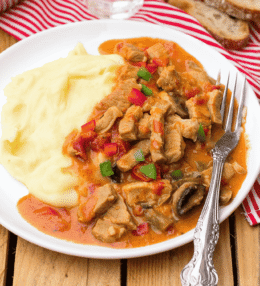
- View
Table of Contents
ToggleRendang is one of those dishes that commands attention the moment it hits the table. Deep, rich, and aromatic, it’s often considered one of Malaysia’s finest culinary achievements. Traditionally served during festivals and special occasions, this slow cooked beef stew represents both celebration and patience in cooking.
Its dark, caramelised exterior and intense flavours are the result of hours of careful simmering, allowing the spices and coconut milk to penetrate every fibre of the meat. The result is tender, fragrant beef coated in a thick, concentrated sauce that speaks of generations of shared recipes and culinary pride.
Want to dive deeper into Malaysian Cuisine? Don’t miss our post on 27 Traditional Malaysian Foods to Try
What Is Rendang?
Rendang is a dry style curry where beef is slow cooked in coconut milk and a blend of fresh herbs and spices until all the liquid evaporates, leaving behind a deeply flavoured coating. Despite being a stew, it’s not soupy but rather thick, with the meat richly glazed in spice infused oil.
What sets rendang apart is its cooking technique. It isn’t rushed. The dish develops layer upon layer of flavour over time, rewarding patience with incredible depth. While beef is most common, some households make it with chicken or lamb, depending on the region or family tradition.
Ingredients and Taste
The soul of rendang lies in its spice paste, usually made from lemongrass, galangal, ginger, garlic, shallots, and dried chillies. These are pounded into a fragrant base, then slow cooked with beef and coconut milk until the oil separates and the paste darkens.
The taste is intense yet balanced. You’ll notice earthy warmth from the spices, sweetness from the coconut, and a gentle heat that lingers but never overwhelms. The beef becomes meltingly tender, while the sauce turns into a thick, flavour packed crust around the meat.
No single element dominates. Instead, you get a chorus of flavours: savoury, spicy, slightly sweet, and deeply aromatic. Some variations include toasted coconut flakes, adding a subtle crunch and enhancing the richness of the dish.
A Taste of History
Rendang has its roots in the Minangkabau community of West Sumatra, Indonesia, but over centuries, it spread across the Malay Archipelago. In Malaysia, it’s now deeply woven into festive traditions, especially during Hari Raya and family celebrations.
The dish was originally designed for preservation. Its long cooking time and use of natural antimicrobials like turmeric and galangal made it ideal for storing without refrigeration. That practicality, combined with its complex taste, helped it travel and evolve.
In Malaysian kitchens today, rendang is not just food but storytelling in a pot. Each family has their own twist, their own balance of spices, and often, a memory attached to the process of making it. Passed down quietly, refined through repetition, it’s both a meal and a legacy.
To taste rendang is to understand something intimate about Malaysian culture. It invites you to slow down, savour, and respect the process. It’s not fast food. It’s a dish that speaks of time, history, and the joy of cooking with care.

Malaysian Beef Rendang (Slow Cooked Beef Stew)
Ingredients
For the spice paste:
- 6 dried red chillies soaked in hot water until soft
- 5 shallots peeled
- 3 cloves garlic peeled
- 1 inch ginger peeled
- 1 inch galangal peeled
- 1 stalk lemongrass white part only, sliced
- 1 tsp ground turmeric
- 1 tbsp toasted coriander seeds
- 1 tsp toasted cumin seeds
- 1 tbsp vegetable oil for blending
For the stew:
- 800 g beef shin or chuck cut into 2-inch chunks
- 400 ml coconut milk preferably not low fat
- 200 ml water
- 2 kaffir lime leaves torn
- 1 turmeric leaf optional, tied into a knot
- 1 cinnamon stick
- 2 star anise
- 1 tbsp kerisik toasted grated coconut, see tips below
- Salt to taste
- 1 tbsp palm sugar or brown sugar as a substitute
Instructions
- To begin, prepare the spice paste. In a food processor or blender, combine the softened chillies, shallots, garlic, ginger, galangal, lemongrass, turmeric, coriander, and cumin. Add the oil to help it blend smoothly. Blitz until a fine, aromatic paste forms. Scrape down the sides as needed for an even blend.
- Heat 2 tablespoons of oil in a heavy bottomed pot or Dutch oven over medium heat. Add the spice paste and sauté slowly for 8–10 minutes, stirring frequently. Cook until the paste darkens and the oil begins to separate, a key step in developing deep flavour.
- Add the beef pieces to the pot, stirring to coat thoroughly in the aromatic paste. Cook for 5–7 minutes, allowing the meat to brown slightly and absorb the base flavours. Stir constantly to prevent sticking and ensure even browning.
- Pour in the coconut milk and water. Stir gently to combine, then add the kaffir lime leaves, turmeric leaf (if using), cinnamon stick, and star anise. Bring to a gentle boil, then immediately reduce the heat to a low simmer.
- Partially cover the pot with a lid and simmer gently for 2 hours, stirring occasionally. Keep the heat low to avoid curdling the coconut milk. If the mixture dries too quickly, add a splash of water to maintain the stew’s consistency.
- After 2 hours, uncover and continue simmering for another 30–45 minutes, stirring more frequently. The liquid should reduce significantly, concentrating into a thick, rich gravy that clings to the meat. Stir gently to prevent burning at the bottom.
- Once the sauce is deeply caramelised and coats the beef well, stir in the kerisik and palm sugar. Continue to cook for a further 10 minutes. The kerisik adds an essential toasted coconut depth that is signature to rendang.
- Taste and adjust the seasoning with salt and more sugar if needed. The balance should lean towards savoury and spiced, with subtle sweetness and earthy richness from the toasted coconut.
- Allow the rendang to rest for at least 20 minutes before serving. This allows the flavours to mellow and settle. The stew often tastes even better the next day, as the spices have more time to infuse the beef.
- Serve the rendang warm, garnished with extra kerisik or thinly sliced red chillies for a bit of colour. Traditionally paired with steamed jasmine rice, sticky rice, or lemang (glutinous rice in banana leaf). A side of fresh cucumber slices or pickled vegetables adds a cooling contrast to the richness.
Nutrition
You May Also Like







Leave a Review